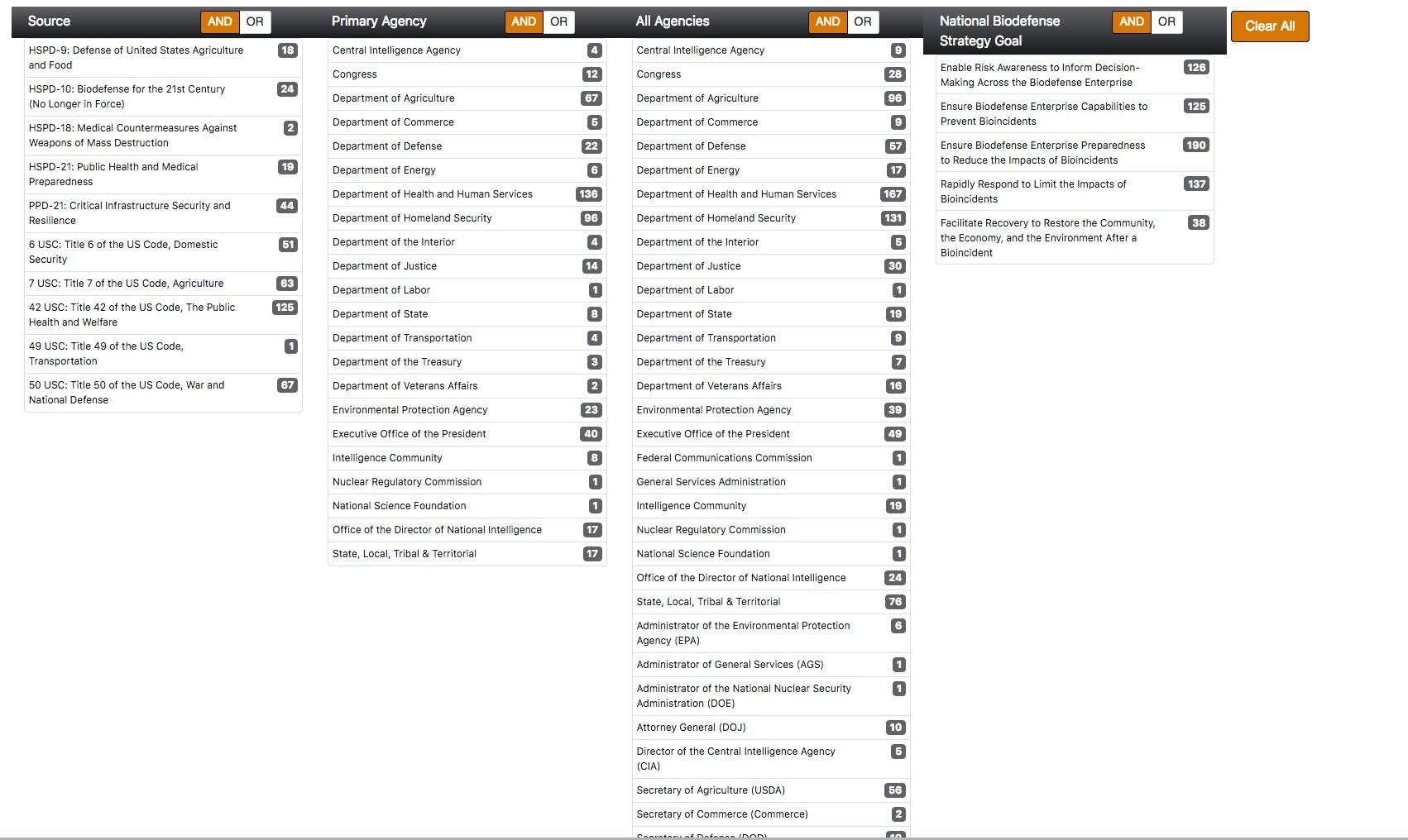Making sense of the 2018 National Biodefense Strategy
By Rachel Bartholomew, Kristin Omberg | January 18, 2019
 An airman posing as a biological attack victim cries as she receives care from a decontamination team member during an exercise at Barksdale Air Force Base in November 2017. Credit: Staff Sgt. Benjamin Raughton/US Air Force
An airman posing as a biological attack victim cries as she receives care from a decontamination team member during an exercise at Barksdale Air Force Base in November 2017. Credit: Staff Sgt. Benjamin Raughton/US Air Force
It has been 100 years since the end of World War I, the “war to end all wars,” which set the precedent for modern biological warfare. The 1925 Geneva Protocol subsequently banned the use of biological weapons in war but did not stop the proliferation of state-sponsored bioweapons programs. With the spread of such programs and other biologically based threats, the United States and other nations have made a variety of efforts to defend against them.
In September, the Trump administration unveiled its long-awaited National Biodefense Strategy. This week, Pacific Northwest National Laboratory released a second-generation, publicly available tool—free for use at https://bplat.pnnl.gov—that maps out current biodefense responsibilities and brings clarity to the tangle of laws, directives, and agencies that together protect US citizens. The Biodefense Policy Landscape Analysis Tool, or B-PLAT, is affectionately called the “spaghetti monster,” because it visualizes information using spaghetti-like strands to demonstrate relationships between agencies, their specific responsibilities, and the degree of complexity and interconnectedness of the biodefense policy domain.
An evolving national strategy. To understand how B-PLAT fits into today’s framework for protecting the nation, it’s useful to review some of the history that resulted in today’s efforts. In 1975, the Biological Weapons Convention entered into force, prohibiting signatories from developing, producing, or stockpiling biological weapons and ending overt state programs. Over the next quarter-century, the United States enacted laws regulating the transport and export of biological agents and toxins but had no formal biodefense strategy.
The anthrax attacks of 2001 precipitated the enactment of more than a dozen laws and directives pertaining to biodefense. For example, Homeland Security Presidential Directive-10, issued in 2004 and titled “Biodefense for the 21st Century,” explicitly stated that bioweapons “pose unique and grave threats to the safety and security of the United States and our allies” and outlined an initial strategy for addressing the threat. The directive and its companion documents, produced by the George W. Bush administration, focused on establishing capabilities to prevent, recognize, and mitigate a deliberate biological attack, and elucidated the roles of key stakeholders, including the then-newly formed Department of Homeland Security.
The Obama administration’s 2009 National Strategy for Countering Biological Threats built upon Bush-era documents but strongly emphasized promoting global health security and addressing “public health crises of natural, accidental, or deliberate origin.” The 2012 National Strategy for Biosurveillance further broadened the scope by advocating an approach encompassing human, animal, and plant health and including federal, state, local, and tribal governments, the private sector, nongovernmental organizations, and international partners.
By 2015, with the Bush- and Obama-era policies still in effect, some form of responsibility for biodefense had been assigned to at least 19 departments or agencies, three executive offices, 50 political appointees, and all state, local, tribal, and territorial governments. Partly as a result, the 2015 bipartisan report of the Blue Ribbon Study Panel on Biodefense warned that despite “a decade of profusion of policy directives,” the United States had failed to produce a comprehensive biodefense strategy spanning prevention to recovery.
Lawmakers took notice, and the National Defense Authorization Act for Fiscal Year 2017 required the secretaries of Defense, Health and Human Services, Homeland Security, and Agriculture to produce a comprehensive strategy. Thus the National Biodefense Strategy of 2018 was born. But the profusion of policy directives remains.
The new strategy continues to reinforce the broad scope of the biological threat, including naturally occurring infectious disease, the deliberate use of bioweapons by states, and the growing presence of non-state actors—and now acknowledges new stakeholders within biodefense: the enthusiast community, which includes do-it-yourself biologists. The main advancement is the acknowledgement that many agencies at multiple levels—including federal agencies, but also state and other government entities as well as the private sector—have a role in biodefense policy. The strategy includes a mandate that all stakeholders with a role in detection, prevention, preparedness, response, or recovery share information and coordinate decision making.
How B-PLAT can help. To implement its strategy, the Trump administration created a Biodefense Steering Committee, tasked with coordinating hundreds of responsibilities assigned to a vast swath of government. The implementation plan is due in March 2019—a tight time frame for a task this size.
B-PLAT is designed to help, serving as a resource for anyone interested in the complexities of US biodefense. The tool was originally released in 2017 and has been updated to reflect the National Biodefense Strategy. B-PLAT 2.0, the second-generation version of the tool, now includes 414 discrete responsibilities assigned to 22 agencies.
To create the original version of B-PLAT, we extracted hundreds of responsibilities from an array of directives, including three enduring Bush-era presidential directives, one Obama-era directive, and five titles of the Code of Laws of the United States (covering domestic security, agriculture, public health and welfare, and war and national defense). Responsibilities were organized, or tagged, using the four “pillars” of biodefense as defined by the 2004 presidential directive. We used the same organizing principle for B-PLAT 2.0, with additional tags added for the National Biodefense Strategy’s five goals. Although the new strategy supersedes the older pillars, they remain in B-PLAT 2.0 for historical comparison.
B-PLAT 2.0 aims to tackle a mountain of useful information that, unfortunately, can be cumbersome to navigate. For instance, responsibilities are frequently assigned to multiple designees; it is not uncommon to find one responsibility assigned to five or more agencies, with no delineation of specific roles. It is also common for seemingly overlapping responsibilities to be assigned to disparate agencies. For example, we identified more than 20 responsibilities for disease surveillance across all sources, assigned to at least five federal agencies and all state, local, tribal, and territorial governments. One federal law directs the Department of Health and Human Services to “establish a near real-time electronic nationwide public health situational awareness capability,” while another law tasks the Department of Homeland Security with detecting any “biological event of national concern” by integrating data from human health, animal, plant, food, and environmental surveillance. In B-PLAT 2.0, both of these responsibilities are tagged with the new strategy goal (“Enable Risk Awareness to Inform Decision-Making”), the old pillar (“Surveillance & Detection”), and the activity (“surveillance”) to help users identify similar responsibilities.
To help make sense of the requirements called out in the presidential directives and US code and how they fit together, B-PLAT 2.0 provides several alternatives for sorting and visualizing data. The Faceted Responsibilities Browser and the Responsibilities Index sort data from the National Biodefense Strategy by source, agency, and goal. Selecting a primary agency displays the responsibilities assigned only to that agency; another option allows a user to parse the responsibilities assigned to two or more agencies.

Flow diagrams explore interrelationships among the responsibilities and their designees and compare the relative number of responsibilities in a particular category. For example, the “National Biodefense Strategy” visualization shows how the nation’s 414 biodefense responsibilities align with the strategy’s five goals and are assigned to agencies. The “Health and Human Services and Co-Primary Agencies” diagram demonstrates how the responsibilities assigned to the Department of Health and Human Services map to the 2018 strategy and overlap with the responsibilities of other agencies.
A complex enterprise. The original goal of B-PLAT was to elucidate the nation’s biodefense policy. Unfortunately, the complexity of the existing policy largely defies this effort—but this finding itself is illuminating.
One goal of the National Biodefense Strategy is to increase coordination within the national biodefense community. An effort to untangle the “spaghetti” and simplify the relationships among the multitude of stakeholders, using resources such as B-PLAT 2.0, is an excellent place to start.
Together, we make the world safer.
The Bulletin elevates expert voices above the noise. But as an independent nonprofit organization, our operations depend on the support of readers like you. Help us continue to deliver quality journalism that holds leaders accountable. Your support of our work at any level is important. In return, we promise our coverage will be understandable, influential, vigilant, solution-oriented, and fair-minded. Together we can make a difference.
















How are health care first responders factored in, as studies show they will leave their posts during an actual bioterror event such as smallpox? The ensuing panic in the general population may actually be worse than the event itself.